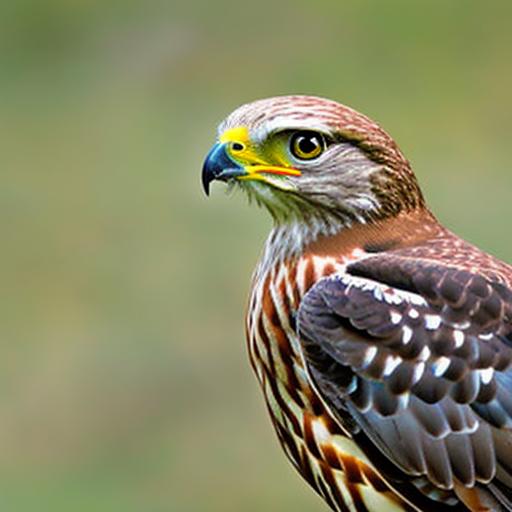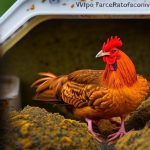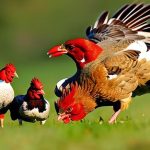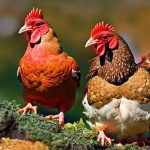Hawks are a common predator that can pose a threat to backyard chicken flocks. These birds of prey have keen eyesight and sharp talons, making them formidable hunters. If you have chickens, it is important to take steps to protect your flock from hawks. In this article, we will discuss the reasons why hawks target chickens, the different types of hawks that may pose a threat, and various strategies you can employ to keep your chickens safe.
Key Takeaways
- Hawks target chickens as a source of food and are a common threat to backyard flocks.
- Identifying common hawk species and their habits can help you better protect your chickens.
- Creating a safe and secure chicken coop with the right wire and fencing is crucial in keeping hawks out.
- Deterrents such as reflective tape and scare tactics like fake owls can help keep hawks away.
- Utilizing natural predators like dogs or cats can help control hawk populations and protect your chickens.
Understanding the Threat: Why Hawks Target Chickens
Hawks target chickens for several reasons. Firstly, chickens are relatively easy prey for hawks. They are ground-dwelling birds that lack the ability to fly long distances or quickly escape from predators. Additionally, chickens are often kept in open areas with little natural cover, making them more vulnerable to hawk attacks.
Secondly, hawks are opportunistic hunters and will go after any available food source. Chickens provide a readily available and nutritious meal for hawks. Hawks have sharp talons that can easily grasp and kill a chicken, and their powerful beaks can tear through flesh and feathers.
Lastly, hawks are territorial birds and may view your backyard as their hunting ground. If they spot chickens in your yard, they may see them as competition for food and territory and will attack to eliminate the perceived threat.
Identifying Common Hawk Species and Their Habits
There are several species of hawks that may target your chickens. The most common ones include the Cooper’s hawk, the red-tailed hawk, and the sharp-shinned hawk.
The Cooper’s hawk is a medium-sized hawk known for its agility and speed. It is an expert hunter that preys on small to medium-sized birds, including chickens. The red-tailed hawk is one of the largest hawks in North America and is known for its distinctive red tail feathers. It primarily hunts small mammals but will also go after chickens if given the opportunity. The sharp-shinned hawk is a small hawk that specializes in hunting small birds. It is known for its quick and agile flight, making it a formidable predator for chickens.
These hawks have different hunting habits and behaviors. Some may prefer to hunt from perches, while others may engage in aerial hunting. Understanding the habits of the hawks in your area can help you develop effective strategies to protect your flock.
Creating a Safe and Secure Chicken Coop
| Aspect | Metric |
|---|---|
| Size | Minimum of 4 square feet per chicken |
| Roosting | Provide at least 8 inches of roosting space per chicken |
| Nesting | Provide one nesting box for every 3-4 chickens |
| Ventilation | Ensure proper ventilation to prevent respiratory issues |
| Lighting | Provide 14-16 hours of light per day for optimal egg production |
| Security | Use sturdy materials and secure locks to prevent predators from entering |
| Cleanliness | Clean coop and nesting boxes regularly to prevent disease and pests |
One of the most important steps in protecting your flock from hawks is to create a safe and secure chicken coop. The coop should be constructed with sturdy materials and have a solid roof to prevent hawks from swooping down and grabbing chickens.
Ensure that the coop has secure doors and windows that can be closed at night to keep hawks out. Install hardware cloth or heavy-gauge wire mesh over windows and vents to prevent hawks from gaining access to your chickens.
It is also important to reinforce the perimeter of the coop with buried wire or fencing to prevent hawks from digging under and gaining access. Regularly inspect the coop for any gaps or weak spots that could allow hawks to enter.
Choosing the Right Chicken Wire and Fencing
Choosing the right chicken wire and fencing is crucial in keeping hawks out of your chicken coop. Opt for heavy-duty chicken wire with smaller mesh size to prevent hawks from reaching through and grabbing chickens.
Consider using electric fencing as an additional deterrent. Electric fencing can provide a shock to hawks that attempt to land or fly over it, discouraging them from targeting your chickens.
It is important to ensure that the fencing is tall enough to deter hawks from flying over it. A height of at least 6 feet is recommended, as most hawks will not attempt to fly over such a barrier.
Using Deterrents to Keep Hawks at Bay

There are various deterrents that can be used to keep hawks away from your chickens. One effective method is to use visual deterrents, such as scarecrows, reflective tape, or shiny objects like CDs or aluminum foil. These visual deterrents can confuse and intimidate hawks, making them less likely to target your chickens.
Another effective deterrent is the use of noise. Hawks are sensitive to loud and sudden noises, so using devices like wind chimes, bells, or even a radio playing at a high volume can help deter them.
You can also consider using motion-activated sprinklers or lights to startle hawks when they approach your chicken coop. These sudden bursts of water or light can be effective in deterring hawks from targeting your flock.
Implementing Scare Tactics to Keep Hawks Away
In addition to deterrents, scare tactics can also be employed to keep hawks away from your chickens. One common scare tactic is the use of predator decoys. Placing decoy animals, such as owls or snakes, near your chicken coop can create the illusion of a predator presence and deter hawks from approaching.
Another scare tactic is the use of trained dogs or falcons. These animals can be trained to patrol the area around your chicken coop and scare off hawks. The presence of a larger predator can be enough to keep hawks at bay.
Utilizing Natural Predators to Control Hawk Populations
One natural way to control hawk populations is by attracting and providing habitat for their natural predators. Owls and larger raptors, such as eagles or falcons, are natural predators of hawks and can help keep their populations in check.
You can attract owls by installing owl boxes or providing perches and nesting sites for them. Owls are nocturnal hunters and will prey on hawks during the night, reducing the risk to your chickens.
Similarly, attracting larger raptors can help deter hawks from your property. These larger birds of prey will view hawks as competition and may drive them away from your chickens.
Providing Adequate Shelter and Cover for Chickens
Providing adequate shelter and cover for your chickens is essential in protecting them from hawks. Hawks are less likely to attack chickens that have access to hiding spots or areas of dense vegetation.
Planting trees or shrubs around your chicken coop can provide natural cover for your flock. Ensure that the vegetation is dense enough to provide adequate protection but not so dense that it becomes a hiding spot for predators.
You can also provide additional shelter within the chicken coop itself. Install roosting bars or platforms at different heights to give chickens a place to perch and escape from ground-level predators like hawks.
Managing Your Flock’s Feeding Habits to Minimize Risk
Managing your flock’s feeding habits can help minimize the risk of attracting hawks. Avoid leaving food out in the open, as this can attract not only chickens but also other small animals that hawks prey upon.
Instead, feed your chickens in covered areas or use feeders that can be closed when not in use. This will help reduce the chances of attracting hawks to your property.
Additionally, consider using feeders that require chickens to enter a confined space to access the food. This can make it more difficult for hawks to target individual chickens while they are feeding.
Staying Vigilant and Taking Action to Protect Your Chickens
Staying vigilant and taking action is crucial in protecting your chickens from hawks. Regularly inspect your chicken coop and fencing for any signs of damage or weakness that could allow hawks to gain access.
Monitor the behavior of your flock and be on the lookout for any signs of distress or unusual activity. If you notice a hawk in the vicinity, take immediate action to scare it away and protect your chickens.
Educate yourself about the local hawk species and their habits. This knowledge will help you develop effective strategies to deter hawks and keep your flock safe.
Protecting your flock from hawks requires a combination of proactive measures and vigilance. By understanding the threat that hawks pose, identifying common hawk species, and implementing strategies such as creating a secure chicken coop, choosing the right fencing, using deterrents and scare tactics, utilizing natural predators, providing adequate shelter and cover, managing feeding habits, and staying vigilant, you can greatly reduce the risk to your chickens. Take action today to protect your flock from hawks and ensure their safety and well-being.
If you’re looking for ways to protect your chickens from hawks, check out this helpful article on Poultry Wizard: How to Keep Hawks Away from Chickens. It provides valuable tips and strategies to keep these predatory birds at bay and ensure the safety of your flock. From understanding hawk behavior to implementing effective deterrents, this article covers everything you need to know. Don’t let hawks threaten your chickens any longer – learn how to protect them with the guidance of Poultry Wizard.
FAQs
What are hawks?
Hawks are birds of prey that belong to the family Accipitridae. They are known for their sharp talons, hooked beaks, and keen eyesight, which they use to hunt and kill small animals.
Why do hawks attack chickens?
Hawks see chickens as a source of food. They are attracted to the movement and noise of the chickens, and will swoop down to catch them if they get the chance.
What are the signs of a hawk attack on chickens?
The signs of a hawk attack on chickens include missing or injured birds, feathers scattered around the coop or yard, and talon marks on the remaining chickens.
How can I keep hawks away from my chickens?
There are several ways to keep hawks away from your chickens, including using scare tactics like fake owls or shiny objects, providing cover for the chickens to hide under, and keeping the chickens in a covered run or coop.
Are there any natural predators of hawks?
Yes, hawks have natural predators such as eagles, owls, and larger hawks. However, these predators are not always present in the same area as the hawks, and may not be effective at keeping them away from chickens.
Is it legal to kill hawks that are attacking my chickens?
No, it is illegal to kill hawks or any other birds of prey in the United States without a permit. Hawks are protected under the Migratory Bird Treaty Act, which makes it illegal to harm or kill them.
Meet Walter, the feathered-friend fanatic of Florida! Nestled in the sunshine state, Walter struts through life with his feathered companions, clucking his way to happiness. With a coop that’s fancier than a five-star hotel, he’s the Don Juan of the chicken world. When he’s not teaching his hens to do the cha-cha, you’ll find him in a heated debate with his prized rooster, Sir Clucks-a-Lot. Walter’s poultry passion is no yolk; he’s the sunny-side-up guy you never knew you needed in your flock of friends!







